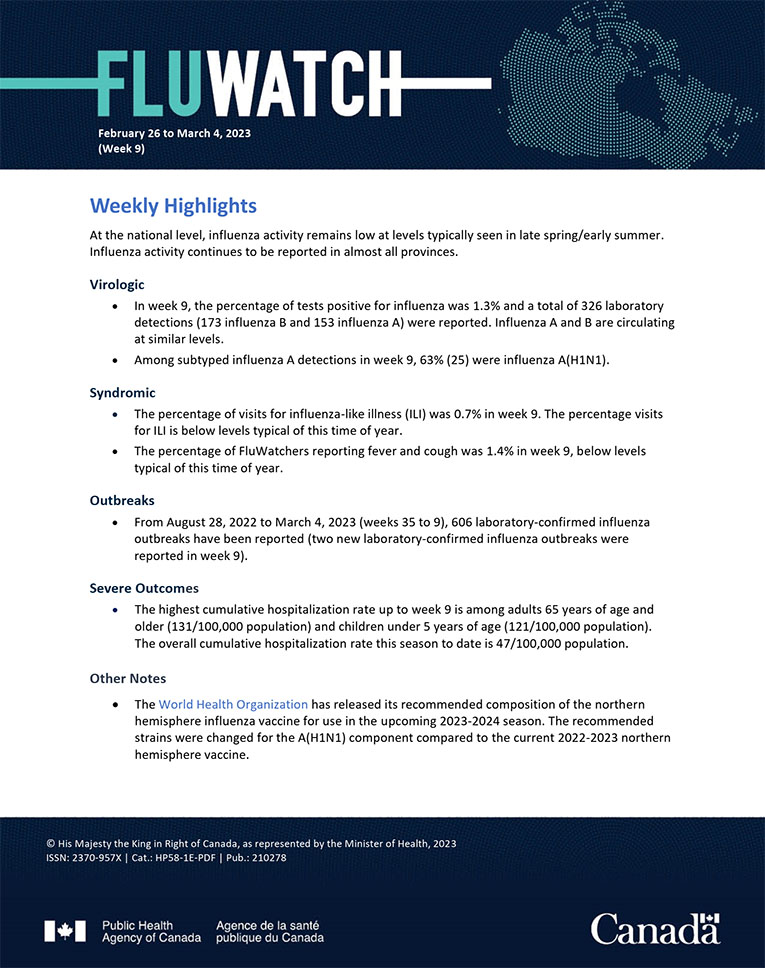FluWatch report: February 26 to March 4, 2023 (week 9)
Download in PDF format
(1.15 MB, 12 pages)
Organization: Public Health Agency of Canada
Published: 2023-03-10
Related Topics
Weekly Highlights
- At the national level, influenza activity remains low at levels typically seen in late spring/early summer. Influenza activity continues to be reported in almost all provinces.
Virologic
- In week 9, the percentage of tests positive for influenza was 1.3% and a total of 326 laboratory detections (173 influenza B and 153 influenza A) were reported. Influenza A and B are circulating at similar levels.
- Among subtyped influenza A detections in week 9, 63% (25) were influenza A(H1N1).
Syndromic
- The percentage of visits for influenza-like illness (ILI) was 0.7% in week 9. The percentage visits for ILI is below levels typical of this time of year.
- The percentage of FluWatchers reporting fever and cough was 1.4% in week 9, below levels typical of this time of year.
Outbreaks
- From August 28, 2022 to March 4, 2023 (weeks 35 to 9), 606 laboratory-confirmed influenza outbreaks have been reported (two new laboratory-confirmed influenza outbreaks were reported in week 9).
Severe Outcomes
- The highest cumulative hospitalization rate up to week 9 is among adults 65 years of age and older (131/100,000 population) and children under 5 years of age (121/100,000 population). The overall cumulative hospitalization rate this season to date is 47/100,000 population.
Other Notes
- The World Health Organization has released its recommended composition of the northern hemisphere influenza vaccine for use in the upcoming 2023-2024 season. The recommended strains were changed for the A(H1N1) component compared to the current 2022-2023 northern hemisphere vaccine.
On this page
- Influenza/Influenza-like Illness Activity - Geographic Spread
- Laboratory-Confirmed Influenza Detections
- Syndromic / Influenza-like Illness Surveillance
- Influenza Outbreak Surveillance
- Influenza Severe Outcomes Surveillance
- Influenza Strain Characterization
- Antiviral Resistance
- Influenza Vaccine Monitoring
- Provincial and International Influenza Reports
Influenza/Influenza-like Illness Activity - Geographic Spread
In week 9, 33 regions across Canada reported either sporadic or localized influenza activity (Figure 1). The number of regions reporting influenza activity and the intensity of reported activity remains stable. A total of 16 regions in Canada reported no activity this week.
Number of Regions Reporting in Week 9: 49 out of 53
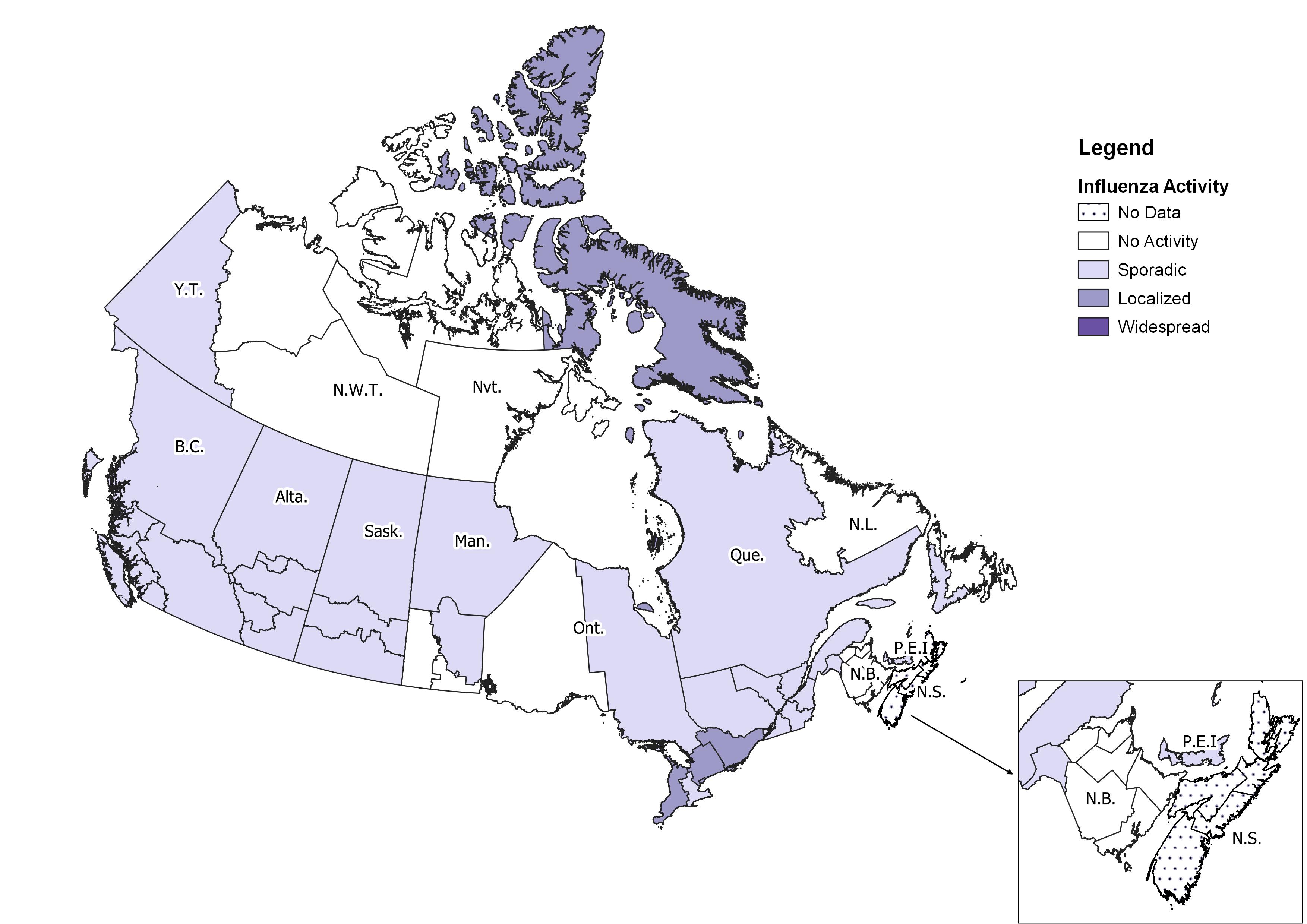
Figure 1 - Text description
| Province | Influenza Surveillance Region | Activity Level |
|---|---|---|
| N.L. | Eastern | No Activity |
| N.L. | Labrador-Grenfell | No Activity |
| N.L. | Central | No Activity |
| N.L. | Western | Sporadic |
| P.E.I. | Prince Edward Island | Sporadic |
| N.S. | Zone 1 - Western | No Data |
| N.S. | Zone 2 - Northern | No Data |
| N.S. | Zone 3 - Eastern | No Data |
| N.S. | Zone 4 - Central | No Data |
| N.B. | Region 1 | No Activity |
| N.B. | Region 2 | No Activity |
| N.B. | Region 3 | No Activity |
| N.B. | Region 4 | Sporadic |
| N.B. | Region 5 | No Activity |
| N.B. | Region 6 | No Activity |
| N.B. | Region 7 | No Activity |
| Que. | Nord-est | Sporadic |
| Que. | Québec et Chaudieres-Appalaches | Sporadic |
| Que. | Centre-du-Québec | Sporadic |
| Que. | Montréal et Laval | Sporadic |
| Que. | Ouest-du-Québec | Sporadic |
| Que. | Montérégie | Sporadic |
| Ont. | Central East | Localized |
| Ont. | Central West | Sporadic |
| Ont. | Eastern | Localized |
| Ont. | North East | Sporadic |
| Ont. | North West | No Activity |
| Ont. | South West | Localized |
| Ont. | Toronto | Localized |
| Man. | Northern Regional | Sporadic |
| Man. | Prairie Mountain | No Activity |
| Man. | Interlake-Eastern | Sporadic |
| Man. | Winnipeg | Sporadic |
| Man. | Southern Health | No Activity |
| Sask. | North | Sporadic |
| Sask. | Central | Sporadic |
| Sask. | South | Sporadic |
| Alta. | North Zone | Sporadic |
| Alta. | Edmonton | Sporadic |
| Alta. | Central Zone | Sporadic |
| Alta. | Calgary | Sporadic |
| Alta. | South Zone | Sporadic |
| B.C. | Interior | Sporadic |
| B.C. | Fraser | Sporadic |
| B.C. | Vancouver Coastal | Sporadic |
| B.C. | Vancouver Island | Sporadic |
| B.C. | Northern | Sporadic |
| Y.T. | Yukon | Sporadic |
| N.W.T. | North | No Activity |
| N.W.T. | South | No Activity |
| Nvt. | Qikiqtaaluk | Localized |
| Nvt. | Kivalliq | No Activity |
| Nvt. | Kitimeot | No Activity |
Laboratory-Confirmed Influenza Detections
In week 9, the weekly percentage of tests positive for influenza was 1.3% and is at interseasonal levels.
The following results were reported from sentinel laboratories across Canada in week 9 (Figures 2 and 3):
- A total of 326 laboratory detections (173 influenza B and 153 influenza A) were reported. Influenza A and B are circulating at similar levels.
- Among subtyped influenza A detections (40), 63% (25) were influenza A(H1N1).
- Among detections for which age information was reported (218), 60 (28%) of detections were in individuals aged 20-44 years.
To date this season (August 28, 2022 to March 4, 2023):
- 66,028 influenza detections were reported, of which 99% (65,142) were influenza A and among subtyped influenza A detections (20,455), influenza A(H3N2) accounted for 92% of detections.
- • 46,678 laboratory-confirmed influenza detections with age information were reported, of which 19,093 (41%) were in individuals aged 0-19 years old (Figure 4).
For more detailed weekly and cumulative influenza data, see the text descriptions for Figures 2 and 3 or the Respiratory Virus Detections in Canada Report.
Number of Laboratories Reporting in Week 9: 33 out of 35
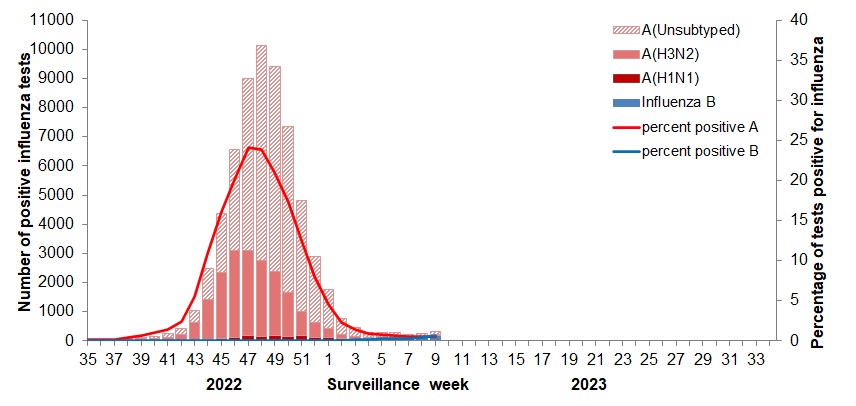
Figure 2 - Text description
| Surveillance Week | A(Unsubtyped) | A(H3N2) | A(H1N1) | Influenza B | Percent Positive A | Percent Positive B | |
|---|---|---|---|---|---|---|---|
| 35 | 13 | 10 | 2 | 3 | 0.2 | 0.0 | |
| 36 | 9 | 5 | 1 | 5 | 0.1 | 0.0 | |
| 37 | 19 | 9 | 3 | 2 | 0.2 | 0.0 | |
| 38 | 26 | 35 | 20 | 3 | 0.5 | 0.0 | |
| 39 | 44 | 53 | 22 | 5 | 0.7 | 0.0 | |
| 40 | 64 | 66 | 16 | 4 | 1.0 | 0.0 | |
| 41 | 121 | 110 | 20 | 1 | 1.4 | 0.0 | |
| 42 | 218 | 204 | 11 | 9 | 2.4 | 0.1 | |
| 43 | 418 | 595 | 23 | 6 | 5.5 | 0.0 | |
| 44 | 1055 | 1351 | 54 | 7 | 10.9 | 0.0 | |
| 45 | 2026 | 2268 | 69 | 11 | 16.2 | 0.0 | |
| 46 | 3453 | 2983 | 98 | 16 | 20.2 | 0.1 | |
| 47 | 5916 | 2912 | 168 | 16 | 24.1 | 0.0 | |
| 48 | 7372 | 2605 | 133 | 13 | 23.8 | 0.0 | |
| 49 | 7028 | 2206 | 141 | 29 | 21.0 | 0.1 | |
| 50 | 5686 | 1507 | 137 | 29 | 17.2 | 0.1 | |
| 51 | 3776 | 849 | 155 | 19 | 12.5 | 0.1 | |
| 52 | 2272 | 506 | 105 | 28 | 8.0 | 0.1 | |
| 1 | 1338 | 316 | 86 | 29 | 4.6 | 0.1 | |
| 2 | 553 | 139 | 54 | 18 | 2.2 | 0.1 | |
| 3 | 326 | 47 | 49 | 44 | 1.4 | 0.1 | |
| 4 | 172 | 40 | 42 | 42 | 0.9 | 0.2 | |
| 5 | 154 | 25 | 35 | 80 | 0.8 | 0.3 | |
| 6 | 138 | 18 | 30 | 94 | 0.7 | 0.3 | |
| 7 | 98 | 11 | 31 | 75 | 0.6 | 0.3 | |
| 8 | 102 | 20 | 20 | 125 | 0.6 | 0.5 | |
| 9 | 100 | 15 | 25 | 173 | 0.6 | 0.7 |
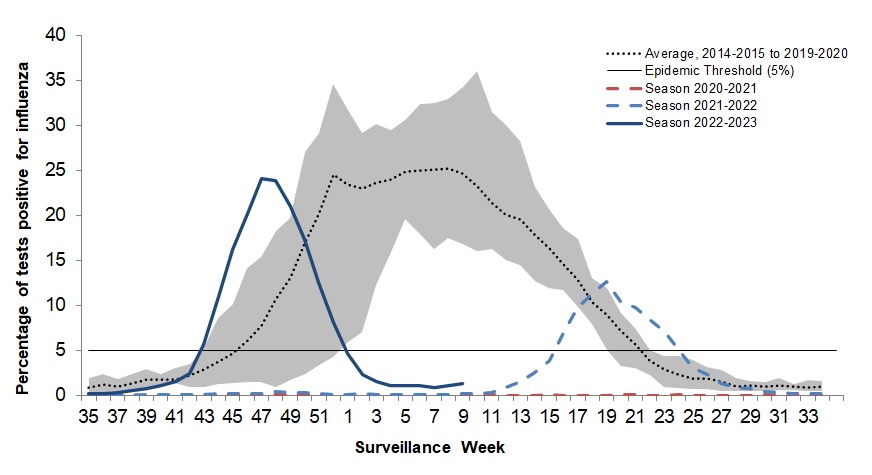
The shaded area represents the maximum and minimum number of influenza tests or percentage of tests positive reported by week from seasons 2014-2015 to 2019-2020. Data from week 11 of the 2019-2020 season onwards are excluded from the historical comparison due to the COVID-19 pandemic.
The epidemic threshold is 5% tests positive for influenza. When it is exceeded, and a minimum of 15 weekly influenza detections are reported, a seasonal influenza epidemic is declared.
Figure 3 - Text description
| Surveillance Week | Percentage of tests positive, 2022-2023 | Percentage of tests positive, 2021-2022 | Percentage of tests positive, 2020-2021 | Maximum Percentage of Tests Positive | Minimum Percentage of Tests Positive | Average Percentage of Tests Positive |
|---|---|---|---|---|---|---|
| 35 | 0.2 | 0.0 | 0.0 | 1.9 | 0.1 | 0.8 |
| 36 | 0.2 | 0.0 | 0.0 | 2.3 | 0.3 | 1.1 |
| 37 | 0.3 | 0.0 | 0.0 | 1.8 | 0.4 | 1.0 |
| 38 | 0.5 | 0.0 | 0.0 | 2.4 | 0.5 | 1.3 |
| 39 | 0.7 | 0.0 | 0.0 | 2.9 | 0.7 | 1.7 |
| 40 | 1.0 | 0.0 | 0.0 | 2.3 | 1.1 | 1.7 |
| 41 | 1.5 | 0.1 | 0.0 | 3.0 | 1.3 | 1.7 |
| 42 | 2.4 | 0.1 | 0.0 | 3.4 | 0.9 | 2.2 |
| 43 | 5.6 | 0.1 | 0.0 | 5.3 | 0.8 | 2.8 |
| 44 | 10.9 | 0.2 | 0.1 | 8.5 | 1.2 | 3.7 |
| 45 | 16.2 | 0.1 | 0.0 | 10.1 | 1.4 | 4.6 |
| 46 | 20.2 | 0.2 | 0.0 | 14.1 | 1.5 | 6.1 |
| 47 | 24.1 | 0.2 | 0.1 | 15.4 | 1.4 | 7.7 |
| 48 | 23.9 | 0.3 | 0.1 | 18.2 | 0.8 | 10.6 |
| 49 | 21.0 | 0.3 | 0.0 | 19.7 | 1.6 | 13.0 |
| 50 | 17.3 | 0.3 | 0.0 | 27.0 | 2.4 | 16.8 |
| 51 | 12.6 | 0.2 | 0.0 | 29.1 | 3.3 | 20.1 |
| 52 | 8.0 | 0.1 | 0.0 | 34.5 | 4.3 | 24.5 |
| 1 | 4.7 | 0.1 | 0.0 | 31.7 | 5.8 | 23.4 |
| 2 | 2.3 | 0.1 | 0.0 | 29.1 | 7.1 | 23.0 |
| 3 | 1.5 | 0.1 | 0.0 | 30.1 | 12.2 | 23.6 |
| 4 | 1.1 | 0.1 | 0.0 | 29.5 | 15.9 | 24.0 |
| 5 | 1.0 | 0.0 | 0.0 | 30.6 | 19.6 | 24.9 |
| 6 | 1.0 | 0.1 | 0.0 | 32.4 | 17.9 | 25.0 |
| 7 | 0.8 | 0.0 | 0.0 | 32.5 | 16.3 | 25.1 |
| 8 | 1.1 | 0.1 | 0.0 | 32.9 | 17.5 | 25.1 |
| 9 | 1.3 | 0.1 | 0.0 | 34.3 | 16.8 | 24.6 |
| 10 | N/A | 0.2 | 0.0 | 36.0 | 16.0 | 23.2 |
| 11 | N/A | 0.3 | 0.0 | 31.4 | 16.2 | 21.4 |
| 12 | N/A | 0.9 | 0.0 | 30.0 | 15.0 | 20.1 |
| 13 | N/A | 1.5 | 0.0 | 28.3 | 14.5 | 19.6 |
| 14 | N/A | 2.5 | 0.0 | 23.2 | 12.7 | 17.9 |
| 15 | N/A | 3.9 | 0.0 | 20.7 | 11.9 | 16.3 |
| 16 | N/A | 7.0 | 0.0 | 18.5 | 11.6 | 14.5 |
| 17 | N/A | 9.7 | 0.0 | 17.3 | 9.8 | 12.8 |
| 18 | N/A | 11.3 | 0.0 | 13.0 | 7.9 | 10.3 |
| 19 | N/A | 12.6 | 0.0 | 11.9 | 5.0 | 9.0 |
| 20 | N/A | 10.4 | 0.0 | 9.1 | 3.2 | 7.2 |
| 21 | N/A | 9.8 | 0.0 | 7.4 | 3.0 | 5.6 |
| 22 | N/A | 8.4 | 0.0 | 5.0 | 2.2 | 3.9 |
| 23 | N/A | 7.0 | 0.0 | 4.4 | 0.9 | 2.9 |
| 24 | N/A | 5.0 | 0.0 | 4.4 | 0.8 | 2.2 |
| 25 | N/A | 3.0 | 0.0 | 3.9 | 0.6 | 1.9 |
| 26 | N/A | 2.3 | 0.0 | 3.1 | 0.7 | 1.8 |
| 27 | N/A | 1.2 | 0.0 | 2.8 | 0.4 | 1.5 |
| 28 | N/A | 0.8 | 0.0 | 1.8 | 0.4 | 0.9 |
| 29 | N/A | 0.7 | 0.0 | 1.6 | 0.5 | 1.1 |
| 30 | N/A | 0.4 | 0.0 | 1.5 | 0.5 | 0.9 |
| 31 | N/A | 0.3 | 0.0 | 1.9 | 0.6 | 1.1 |
| 32 | N/A | 0.2 | 0.0 | 1.2 | 0.5 | 0.9 |
| 33 | N/A | 0.2 | 0.0 | 1.7 | 0.4 | 0.9 |
| 34 | N/A | 0.2 | 0.0 | 1.6 | 0.4 | 0.9 |
Figure 4 - Proportion of positive influenza specimens by type or subtype and age-group reported through case-based laboratory reporting, Canada, week 2022-35 to 2023-09

Laboratory data notes:
Testing for influenza and other respiratory viruses has been influenced by the current COVID-19 pandemic. Changes in laboratory testing practices may affect the comparability of data to previous seasons.
Due to different testing protocols of laboratories across Canada, some influenza A subtype detection counts may not be included in total influenza A detection counts and percent positivity calculations.
Figure 4 - Text description
| Age Group | Proportion of Influenza A | Proportion of Influenza B | Total Number Influenza Detections |
|---|---|---|---|
| 0 to 4 | 98.6% | 1.4% | 8357 |
| 5 to 19 | 98.3% | 1.7% | 10736 |
| 20 to 44 | 97.6% | 2.4% | 9588 |
| 45 to 64 | 99.1% | 0.9% | 6116 |
| 65+ | 99.6% | 0.4% | 11881 |
| Age Group | Proportion of A(H1N1) | Proportion of A(H3N2) | Total Number of Subtyped Influenza Detections |
|---|---|---|---|
| 0 to 4 | 5.4% | 94.6% | 2836 |
| 5 to 19 | 4.5% | 95.5% | 3566 |
| 20 to 44 | 8.9% | 91.1% | 2875 |
| 45 to 64 | 16.2% | 83.8% | 1844 |
| 65+ | 8.8% | 91.2% | 3583 |
Syndromic / Influenza-like Illness Surveillance
Healthcare Practitioners Sentinel Surveillance
In week 9, 0.7% of visits to healthcare professionals were due to influenza-like illness (ILI) (Figure 5). The percentage of visits for ILI is below expected levels for this time of year.
ILI symptoms are not specific to any one respiratory pathogen and can be due to influenza, or other respiratory viruses, including respiratory syncytial virus and SARS-CoV-2, the virus that causes COVID-19. This makes the percentage of visits for ILI an important indicator of overall respiratory illness morbidity in the community in the presence of co-circulating viruses.
This indicator should be interpreted with caution as there have been changes in healthcare seeking behavior of individuals and a smaller number of sentinels reporting compared to previous seasons.
Number of Sentinels Reporting in Week 9: 37
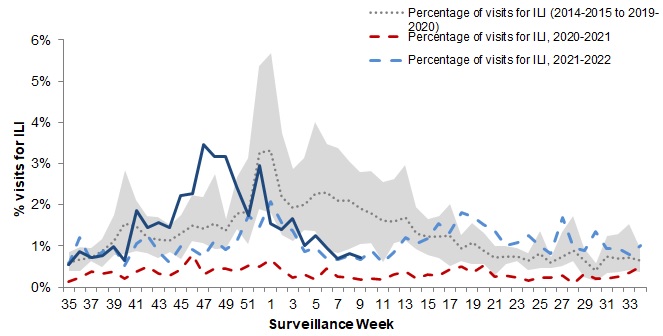
The shaded area represents the maximum and minimum percentage of percentage of participants reporting cough and fever by week, from seasons 2014-2015 to 2019-2020. Data from week 11 of the 2019-2020 season onwards are excluded from the historical comparison due to the COVID-19 pandemic.
Figure 5 - Text description
| Surveillance Week | 2022-2023 | 2021-2022 | 2020-2021 | Average | Min | Max |
|---|---|---|---|---|---|---|
| 35 | 0.6% | 0.6% | 0.1% | 0.6% | 0.4% | 0.9% |
| 36 | 0.9% | 1.2% | 0.2% | 0.6% | 0.4% | 0.9% |
| 37 | 0.7% | 0.6% | 0.4% | 0.7% | 0.5% | 1.0% |
| 38 | 0.8% | 0.9% | 0.3% | 0.7% | 0.6% | 1.0% |
| 39 | 1.0% | 1.0% | 0.4% | 0.9% | 0.5% | 1.2% |
| 40 | 0.7% | 0.5% | 0.2% | 1.2% | 0.8% | 1.7% |
| 41 | 1.9% | 1.1% | 0.4% | 1.7% | 0.8% | 2.8% |
| 42 | 1.4% | 1.2% | 0.5% | 1.6% | 1.2% | 2.1% |
| 43 | 1.6% | 0.9% | 0.3% | 1.2% | 0.8% | 1.7% |
| 44 | 1.5% | 0.6% | 0.3% | 1.2% | 0.7% | 1.7% |
| 45 | 2.2% | 1.0% | 0.4% | 1.2% | 0.9% | 1.5% |
| 46 | 2.3% | 0.9% | 0.8% | 1.4% | 1.2% | 1.8% |
| 47 | 3.5% | 0.7% | 0.3% | 1.6% | 1.1% | 2.2% |
| 48 | 3.2% | 1.1% | 0.5% | 1.5% | 1.1% | 2.2% |
| 49 | 3.2% | 0.9% | 0.5% | 1.7% | 1.0% | 2.8% |
| 50 | 2.4% | 1.1% | 0.4% | 1.5% | 1.1% | 1.7% |
| 51 | 1.7% | 1.7% | 0.5% | 1.9% | 1.4% | 2.7% |
| 52 | 2.9% | 1.5% | 0.5% | 2.0% | 1.0% | 3.1% |
| 1 | 1.6% | 2.1% | 0.7% | 3.4% | 1.9% | 5.4% |
| 2 | 1.4% | 1.6% | 0.4% | 3.4% | 1.8% | 5.7% |
| 3 | 1.7% | 1.4% | 0.2% | 2.3% | 1.3% | 3.7% |
| 4 | 1.0% | 0.9% | 0.3% | 2.0% | 1.1% | 2.9% |
| 5 | 1.3% | 1.0% | 0.2% | 2.1% | 1.4% | 3.1% |
| 6 | 1.0% | 0.7% | 0.5% | 2.4% | 1.4% | 4.0% |
| 7 | 0.7% | 0.7% | 0.3% | 2.4% | 0.9% | 3.5% |
| 8 | 0.8% | 0.8% | 0.2% | 2.3% | 0.8% | 3.4% |
| 9 | 0.7% | 0.7% | 0.2% | 2.3% | 0.9% | 3.1% |
| 10 | N/A | 0.9% | 0.2% | 2.0% | 1.0% | 2.8% |
| 11 | N/A | 0.6% | 0.2% | 1.9% | 1.1% | 2.8% |
| 12 | N/A | 0.8% | 0.3% | 1.6% | 0.6% | 2.6% |
| 13 | N/A | 1.2% | 0.4% | 1.6% | 1.1% | 2.6% |
| 14 | N/A | 1.1% | 0.2% | 1.7% | 1.1% | 3.0% |
| 15 | N/A | 1.2% | 0.3% | 1.3% | 0.9% | 1.9% |
| 16 | N/A | 1.5% | 0.3% | 1.2% | 0.8% | 1.7% |
| 17 | N/A | 1.3% | 0.4% | 1.2% | 0.7% | 1.7% |
| 18 | N/A | 1.8% | 0.5% | 1.3% | 0.5% | 2.0% |
| 19 | N/A | 1.7% | 0.3% | 0.9% | 0.6% | 1.3% |
| 20 | N/A | 1.5% | 0.5% | 1.1% | 0.6% | 1.5% |
| 21 | N/A | 1.4% | 0.3% | 0.9% | 0.5% | 1.3% |
| 22 | N/A | 1.0% | 0.3% | 0.7% | 0.3% | 1.0% |
| 23 | N/A | 1.1% | 0.2% | 0.8% | 0.6% | 1.0% |
| 24 | N/A | 1.3% | 0.2% | 0.7% | 0.6% | 1.0% |
| 25 | N/A | 1.0% | 0.2% | 0.6% | 0.4% | 0.8% |
| 26 | N/A | 0.8% | 0.2% | 0.8% | 0.5% | 1.4% |
| 27 | N/A | 1.7% | 0.3% | 0.6% | 0.5% | 0.7% |
| 28 | N/A | 1.0% | 0.1% | 0.7% | 0.5% | 1.3% |
| 29 | N/A | 0.9% | 0.3% | 0.9% | 0.6% | 1.7% |
| 30 | N/A | 1.3% | 0.2% | 0.6% | 0.2% | 0.9% |
| 31 | N/A | 0.9% | 0.2% | 0.4% | 0.2% | 0.6% |
| 32 | N/A | 0.9% | 0.2% | 0.8% | 0.3% | 1.2% |
| 33 | N/A | 0.8% | 0.3% | 0.7% | 0.4% | 1.3% |
| 34 | N/A | 1.0% | 0.5% | 0.7% | 0.4% | 1.5% |
FluWatchers
In week 9, 9,937 participants reported to FluWatchers, of which 1.4% reported symptoms of cough and fever (Figure 6). The percentage of FluWatchers who have reported cough and fever is well below seasonal levels.
The reports of cough and fever are not specific to any one respiratory pathogen and can be due to influenza, or other respiratory viruses, including respiratory syncytial virus, rhinovirus, and SARS-CoV-2, the virus that causes COVID-19. This makes the proportion of individuals reporting cough and fever an important indicator of overall respiratory illness activity in the community in the presence of co-circulating viruses.
FluWatchers reporting is not impacted by changes in health services or health seeking behaviours.
Among the 137 participants who reported cough and fever:
- 24% consulted a healthcare professional;
- 78% reported days missed from work or school, resulting in an average of 2.8 missed days from work or school among those 107 participants.
The Northwest Territories had the highest participation rate this week (57 participants per 100,000 population) and the neighbourhood with postal code, K0A had the highest number of participants (127). See what is happening in your neighbourhood! Downloadable datasets are also available on Open Maps.
If you are interested in becoming a FluWatcher, sign up today.
Number of Participants Reporting in Week 9: 9,937
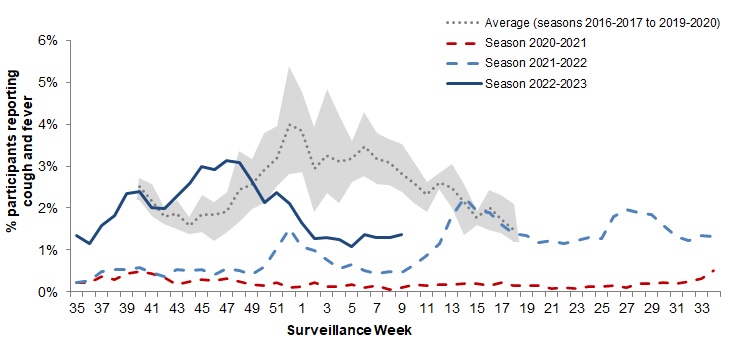
The shaded area represents the maximum and minimum percentage of percentage of participants reporting cough and fever by week, from seasons 2014-2015 to 2019-2020. Data from week 11 of the 2019-2020 season onwards are excluded from the historical comparison due to the COVID-19 pandemic.
Figure 6 - Text description
| Surveillance Week | 2022-2023 | 2021-2022 | 2020-2021 | Average | Min | Max |
|---|---|---|---|---|---|---|
| 35 | 1.3% | 0.2% | 0.2% | N/A | N/A | N/A |
| 36 | 1.2% | 0.3% | 0.2% | N/A | N/A | N/A |
| 37 | 1.6% | 0.5% | 0.4% | N/A | N/A | N/A |
| 38 | 1.8% | 0.5% | 0.3% | N/A | N/A | N/A |
| 39 | 2.3% | 0.5% | 0.4% | N/A | N/A | N/A |
| 40 | 2.4% | 0.6% | 0.5% | 2.5% | 2.2% | 2.7% |
| 41 | 2.0% | 0.5% | 0.4% | 2.2% | 1.8% | 2.6% |
| 42 | 2.0% | 0.4% | 0.3% | 1.8% | 1.6% | 2.0% |
| 43 | 2.3% | 0.5% | 0.2% | 1.9% | 1.5% | 2.2% |
| 44 | 2.6% | 0.5% | 0.3% | 1.6% | 1.4% | 1.8% |
| 45 | 3.0% | 0.5% | 0.3% | 1.8% | 1.4% | 2.3% |
| 46 | 2.9% | 0.4% | 0.3% | 1.8% | 1.2% | 2.2% |
| 47 | 3.1% | 0.6% | 0.3% | 1.9% | 1.4% | 2.4% |
| 48 | 3.1% | 0.5% | 0.3% | 2.4% | 1.7% | 3.4% |
| 49 | 2.7% | 0.4% | 0.2% | 2.6% | 2.0% | 3.2% |
| 50 | 2.1% | 0.6% | 0.1% | 2.9% | 2.1% | 3.8% |
| 51 | 2.4% | 1.0% | 0.2% | 3.2% | 2.5% | 3.9% |
| 52 | 2.1% | 1.5% | 0.1% | 4.0% | 2.8% | 5.4% |
| 1 | 1.7% | 1.1% | 0.1% | 3.8% | 2.9% | 4.8% |
| 2 | 1.3% | 1.0% | 0.2% | 2.9% | 1.9% | 3.9% |
| 3 | 1.3% | 0.8% | 0.1% | 3.3% | 2.3% | 4.8% |
| 4 | 1.2% | 0.6% | 0.1% | 3.1% | 2.1% | 4.2% |
| 5 | 1.1% | 0.6% | 0.2% | 3.2% | 2.6% | 3.6% |
| 6 | 1.4% | 0.5% | 0.1% | 3.5% | 2.8% | 4.3% |
| 7 | 1.3% | 0.4% | 0.2% | 3.2% | 2.6% | 3.8% |
| 8 | N/A | 0.5% | 0.1% | 3.1% | 2.5% | 3.6% |
| 9 | 1.4% | 0.5% | 0.1% | 2.8% | 2.4% | 3.5% |
| 10 | N/A | 0.6% | 0.2% | 2.6% | 2.1% | 3.1% |
| 11 | N/A | 0.9% | 0.2% | 2.3% | 1.9% | 2.6% |
| 12 | N/A | 1.2% | 0.2% | 2.6% | 2.5% | 2.8% |
| 13 | N/A | 1.8% | 0.2% | 2.5% | 2.0% | 3.1% |
| 14 | N/A | 2.3% | 0.2% | 2.1% | 1.3% | 2.6% |
| 15 | N/A | 1.9% | 0.2% | 1.8% | 1.6% | 1.9% |
| 16 | N/A | 1.9% | 0.1% | 2.0% | 1.5% | 2.4% |
| 17 | N/A | 1.6% | 0.2% | 1.7% | 1.4% | 2.3% |
| 18 | N/A | 1.4% | 0.2% | 1.5% | 1.2% | 2.1% |
| 19 | N/A | 1.3% | 0.1% | N/A | N/A | N/A |
| 20 | N/A | 1.2% | 0.2% | N/A | N/A | N/A |
| 21 | N/A | 1.2% | 0.1% | N/A | N/A | N/A |
| 22 | N/A | 1.2% | 0.1% | N/A | N/A | N/A |
| 23 | N/A | 1.2% | 0.1% | N/A | N/A | N/A |
| 24 | N/A | 1.3% | 0.1% | N/A | N/A | N/A |
| 25 | N/A | 1.3% | 0.1% | N/A | N/A | N/A |
| 26 | N/A | 1.8% | 0.2% | N/A | N/A | N/A |
| 27 | N/A | 2.0% | 0.1% | N/A | N/A | N/A |
| 28 | N/A | 1.9% | 0.2% | N/A | N/A | N/A |
| 29 | N/A | 1.8% | 0.2% | N/A | N/A | N/A |
| 30 | N/A | 1.6% | 0.2% | N/A | N/A | N/A |
| 31 | N/A | 1.3% | 0.2% | N/A | N/A | N/A |
| 32 | N/A | 1.2% | 0.3% | N/A | N/A | N/A |
| 33 | N/A | 1.4% | 0.3% | N/A | N/A | N/A |
| 34 | N/A | 1.3% | 0.5% | N/A | N/A | N/A |
Influenza Outbreak Surveillance
In week 9, two laboratory-confirmed influenza A outbreaks in acute care facilities were reported.
To date this season (August 28, 2022 to March 4, 2023):
- 606 laboratory-confirmed influenza outbreaks have been reported
- 329 were in LTC facilities (54%)
- 170 were in facilities categorized as ‘other’ (28%)
- 96 were in acute care facilities (16%)
- 7 were in remote and/or isolated communities (<1%)
- 4 were in schools/daycares (<1%)
- All but two outbreaks were due to influenza A and among those with subtyping information (224), 92% were due to influenza A(H3N2)
- 281 ILI outbreaks have been reported
- All but 3 ILI outbreaks have been reported in schools and/or daycares.
Outbreaks of ILI are not specific to any one respiratory pathogen and can be due influenza, or other respiratory viruses, including respiratory syncytial virus, rhinovirus, COVID-19, or a mixture of viruses. Many respiratory viruses in addition to the flu commonly circulate during the fall and winter, and can cause clusters of cases with respiratory illness which could be captured as ILI.
Number of provinces and territoriesFootnote 1 reporting in Week 9: 12 out of 13
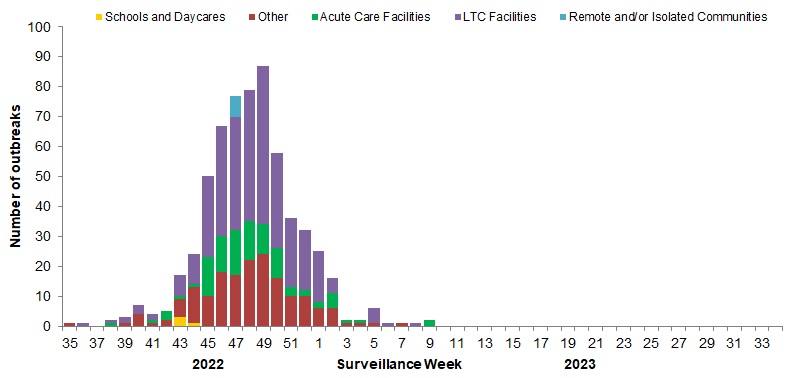
Figure 7 - Text description
| Surveillance Week | Acute Care Facilities | Long Term Care Facilities | Other | Schools and Daycares | Remote and/or Isolated Communities |
|---|---|---|---|---|---|
| 35 | 0 | 0 | 1 | 0 | 0 |
| 36 | 0 | 1 | 0 | 0 | 0 |
| 37 | 0 | 0 | 0 | 0 | 0 |
| 38 | 1 | 1 | 0 | 0 | 0 |
| 39 | 0 | 2 | 1 | 0 | 0 |
| 40 | 0 | 3 | 4 | 0 | 0 |
| 41 | 1 | 2 | 1 | 0 | 0 |
| 42 | 3 | 0 | 2 | 0 | 0 |
| 43 | 1 | 7 | 6 | 3 | 0 |
| 44 | 1 | 10 | 12 | 1 | 0 |
| 45 | 13 | 27 | 10 | 0 | 0 |
| 46 | 12 | 37 | 18 | 0 | 0 |
| 47 | 15 | 38 | 17 | 0 | 7 |
| 48 | 13 | 44 | 22 | 0 | 0 |
| 49 | 10 | 53 | 24 | 0 | 0 |
| 50 | 10 | 32 | 16 | 0 | 0 |
| 51 | 3 | 23 | 10 | 0 | 0 |
| 52 | 2 | 20 | 10 | 0 | 0 |
| 1 | 2 | 17 | 6 | 0 | 0 |
| 2 | 5 | 5 | 6 | 0 | 0 |
| 3 | 1 | 0 | 1 | 0 | 0 |
| 4 | 1 | 0 | 1 | 0 | 0 |
| 5 | 0 | 5 | 1 | 0 | 0 |
| 6 | 0 | 1 | 0 | 0 | 0 |
| 7 | 0 | 0 | 1 | 0 | 0 |
| 8 | 0 | 1 | 0 | 0 | 0 |
| 9 | 2 | 0 | 0 | 0 | 0 |
Influenza Severe Outcomes Surveillance
Provincial/Territorial Influenza Hospitalizations and Deaths
In week 9, two influenza-associated hospitalizations were reported by participating provinces and territoriesFootnote 2.
To date this season (August 28, 2022 to March 4, 2023), 3,951 influenza-associated hospitalizations were reported by participating provinces and territories:
- >99% of the hospitalizations were associated with influenza A.
- Of the cases with subtype information (2,031), 88% were associated with influenza A(H3N2)
- The highest cumulative hospitalization rates up to week 7 were among adults 65 years of age and older (131/100,000 population) and children under 5 years of age (121/100,000 population).
To date this season (August 28, 2022 to March 4, 2023), 332 ICU admissions and 266 influenza-associated deaths were reported.
- Adults aged 45-64 years of age and 65 years of age and older accounted for 29% and 32% of reported ICU admissions respectively.
- Adults aged 65 years of age and older accounted for 76% of reported deaths.
Number of provinces and territories reporting in Week 9: 8 out of 9
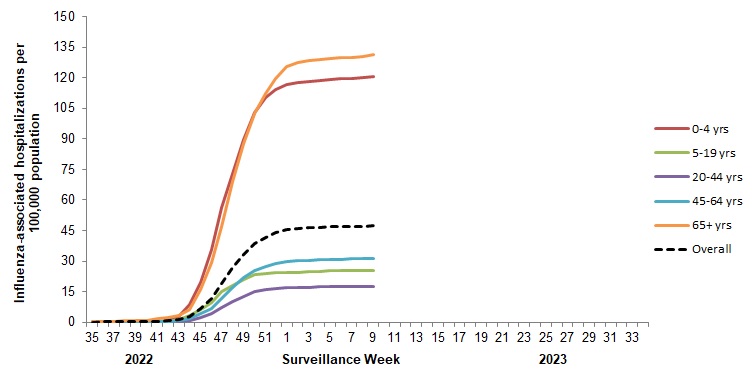
Figure 8 - Text description
| Surveillance Week | 0-4 yrs | 5-19 yrs | 20-44 yrs | 45-64 yrs | 65+ yrs | Overall |
|---|---|---|---|---|---|---|
| 35 | 0.2 | 0.1 | 0.0 | 0.0 | 0.1 | 0.1 |
| 36 | 0.2 | 0.1 | 0.0 | 0.0 | 0.3 | 0.1 |
| 37 | 0.2 | 0.1 | 0.0 | 0.1 | 0.6 | 0.2 |
| 38 | 0.2 | 0.1 | 0.0 | 0.1 | 0.7 | 0.2 |
| 39 | 0.2 | 0.1 | 0.0 | 0.1 | 1.1 | 0.3 |
| 40 | 0.2 | 0.1 | 0.1 | 0.2 | 1.1 | 0.3 |
| 41 | 0.2 | 0.1 | 0.1 | 0.2 | 1.7 | 0.4 |
| 42 | 0.7 | 0.1 | 0.2 | 0.4 | 2.0 | 0.6 |
| 43 | 2.7 | 1.2 | 0.4 | 0.9 | 3.4 | 1.3 |
| 44 | 8.7 | 3.1 | 0.9 | 1.9 | 6.3 | 2.9 |
| 45 | 19.7 | 6.3 | 2.2 | 4.4 | 16.0 | 6.8 |
| 46 | 35.6 | 9.4 | 4.2 | 6.8 | 29.1 | 11.7 |
| 47 | 56.1 | 14.9 | 7.0 | 11.7 | 46.6 | 18.9 |
| 48 | 73.1 | 17.9 | 10.3 | 17.1 | 68.4 | 26.6 |
| 49 | 89.5 | 21.0 | 12.5 | 22.1 | 87.0 | 33.2 |
| 50 | 102.9 | 23.2 | 14.9 | 25.3 | 101.8 | 38.5 |
| 51 | 110.3 | 23.9 | 16.1 | 27.0 | 111.5 | 41.5 |
| 52 | 114.3 | 24.2 | 16.6 | 28.6 | 119.2 | 43.7 |
| 1 | 116.5 | 24.4 | 16.8 | 29.8 | 124.8 | 45.2 |
| 2 | 117.6 | 24.4 | 17.0 | 30.1 | 126.6 | 45.7 |
| 3 | 118.1 | 24.8 | 17.1 | 30.4 | 127.3 | 46.0 |
| 4 | 118.8 | 24.9 | 17.2 | 30.6 | 128.0 | 46.3 |
| 5 | 119.2 | 25.1 | 17.4 | 30.8 | 128.4 | 46.5 |
| 6 | 119.4 | 25.2 | 17.5 | 30.9 | 128.7 | 46.7 |
| 7 | 119.7 | 25.3 | 17.5 | 31.0 | 128.9 | 46.7 |
| 8 | 121.0 | 25.4 | 17.6 | 31.2 | 129.8 | 47.1 |
| 9 | 120.7 | 25.4 | 17.7 | 31.4 | 131.2 | 47.3 |
Pediatric Influenza Hospitalizations and Deaths
In week 9, six influenza-associated pediatric (≤16 years of age) hospitalizations were reported by the Immunization Monitoring Program Active (IMPACT) network (Figure 9). The majority of the weekly hospitalizations were due to influenza B (67%). One influenza-associated ICU admission was reported in week 9. No influenza-associated pediatric deaths have been reported since week 50 (mid December).
To date this season (August 28, 2022 to March 4, 2023):
- 1,549 pediatric influenza-associated hospitalizations have been reported.
- 99% of the hospitalizations were associated with influenza A.
- Children aged between 2-4 years and 5-9 years account for 55% of the reported pediatric hospitalizations (Figure 10).
- 214 ICU admissions were reported; children aged between 2-4 years and 5-9 years account for 50% of the reported pediatric ICU admissions.
- 9 influenza-associated pediatric deaths have been reported.
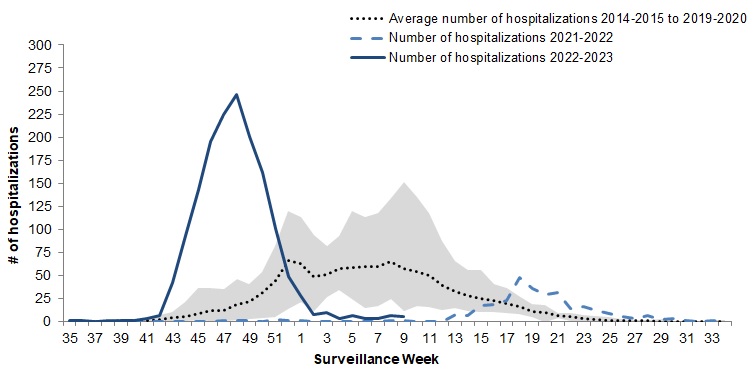
Figure 9 - Text description
| Surveillance week | 2022-2023 | 2021-2022 | Average | Min | Max |
|---|---|---|---|---|---|
| 35 | 1 | 0 | 0 | 0 | 1 |
| 36 | 1 | 0 | 1 | 0 | 2 |
| 37 | 0 | 0 | 1 | 0 | 2 |
| 38 | 1 | 0 | 1 | 0 | 2 |
| 39 | 1 | 0 | 1 | 0 | 3 |
| 40 | 1 | 0 | 1 | 0 | 2 |
| 41 | 4 | 0 | 2 | 0 | 3 |
| 42 | 7 | 0 | 3 | 0 | 7 |
| 43 | 41 | 0 | 4 | 1 | 11 |
| 44 | 92 | 0 | 6 | 1 | 21 |
| 45 | 140 | 0 | 9 | 2 | 36 |
| 46 | 196 | 0 | 12 | 1 | 37 |
| 47 | 228 | 1 | 12 | 1 | 35 |
| 48 | 246 | 1 | 19 | 2 | 46 |
| 49 | 200 | 1 | 22 | 3 | 41 |
| 50 | 163 | 0 | 32 | 4 | 54 |
| 51 | 101 | 2 | 44 | 5 | 82 |
| 52 | 49 | 1 | 66 | 14 | 120 |
| 1 | 28 | 1 | 63 | 21 | 114 |
| 2 | 8 | 0 | 49 | 12 | 94 |
| 3 | 10 | 0 | 51 | 27 | 82 |
| 4 | 3 | 0 | 58 | 34 | 93 |
| 5 | 7 | 0 | 59 | 25 | 120 |
| 6 | 3 | 0 | 60 | 15 | 113 |
| 7 | 4 | 0 | 59 | 17 | 118 |
| 8 | 7 | 1 | 65 | 25 | 134 |
| 9 | 6 | 1 | 58 | 12 | 151 |
| 10 | N/A | 0 | 54 | 17 | 135 |
| 11 | N/A | 0 | 51 | 16 | 118 |
| 12 | N/A | 0 | 39 | 13 | 87 |
| 13 | N/A | 8 | 32 | 15 | 66 |
| 14 | N/A | 7 | 29 | 12 | 56 |
| 15 | N/A | 18 | 25 | 11 | 56 |
| 16 | N/A | 19 | 23 | 11 | 41 |
| 17 | N/A | 23 | 19 | 9 | 37 |
| 18 | N/A | 48 | 16 | 8 | 28 |
| 19 | N/A | 36 | 11 | 5 | 19 |
| 20 | N/A | 29 | 10 | 0 | 18 |
| 21 | N/A | 32 | 6 | 4 | 9 |
| 22 | N/A | 14 | 6 | 1 | 9 |
| 23 | N/A | 16 | 3 | 1 | 7 |
| 24 | N/A | 12 | 3 | 1 | 6 |
| 25 | N/A | 9 | 2 | 0 | 5 |
| 26 | N/A | 6 | 1 | 0 | 3 |
| 27 | N/A | 3 | 1 | 0 | 2 |
| 28 | N/A | 7 | 1 | 0 | 2 |
| 29 | N/A | 2 | 1 | 0 | 3 |
| 30 | N/A | 3 | 1 | 0 | 1 |
| 31 | N/A | 1 | 0 | 0 | 0 |
| 32 | N/A | 0 | 0 | 0 | 0 |
| 33 | N/A | 1 | 0 | 0 | 2 |
| 34 | N/A | 0 | 1 | 0 | 2 |
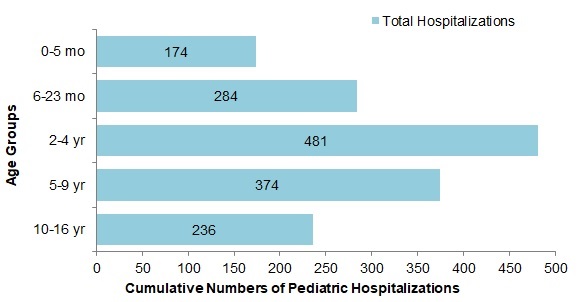
Figure 10 - Text description
| Age Group | Total |
|---|---|
| 0-5 mo | 174 |
| 6-23 mo | 284 |
| 2-4 yr | 481 |
| 5-9 yr | 374 |
| 10-16 yr | 236 |
Influenza Strain Characterization
Since September 1, 2022, the National Microbiology Laboratory (NML) has characterized 373 influenza viruses (334 A(H3N2), 31 A(H1N1), and 3 influenza B) received from Canadian laboratories.
Genetic Characterization of Influenza A(H3N2)
Five influenza A(H3N2) viruses did not grow to sufficient hemagglutination titers for antigenic characterization by hemagglutination inhibition (HI) assays. Therefore, NML has performed genetic characterization to determine the genetic group identity of these viruses.
Sequence analysis of the HA genes of the viruses showed that they belonged to genetic group 3C.2a1b.2a2.
A/Darwin/6/2021 (H3N2)-like virus is an influenza A/H3N2 component of the 2022-23 Northern Hemisphere influenza vaccine and belongs to genetic group 3C.2a1b.2a2.
Antigenic Characterization
Influenza A(H3N2)
- Of the 332 influenza A (H3N2) viruses characterized, 326 were characterized as antigenically similar to A/Darwin/6/2021 (H3N2)-like virus with antisera raised against cell-grown A/Darwin/6/2021 (H3N2)-like virus. Six viruses showed reduced titer with antisera raised against cell-grown A/Darwin/6/2021 (H3N2)-like virus.
- A/Darwin/6/2021 (H3N2)-like virus is an influenza A/H3N2 component of the 2022-23 Northern Hemisphere influenza vaccine.
- The 332 influenza A(H3N2) viruses characterized belonged to genetic group 3C.2a1b.2a2.
Influenza A(H1N1)
- 31 influenza A (H1N1) viruses were characterized as antigenically similar to A/Wisconsin/588/2019-like with ferret antisera produced against cell-propagated A/Wisconsin/588/2019.
- A/Wisconsin/588/2019 is the influenza A/H1N1 component of the 2022-23 Northern Hemisphere influenza vaccine.
Influenza B
- 5 viruses characterized were antigenically similar to B/Austria/1359417/2021.
- Influenza B viruses can be divided into two antigenically distinct lineages represented by B/Yamagata/16/88 and B/Victoria/2/87 viruses.
- The recommended influenza B components for the 2022-23 Northern Hemisphere influenza vaccine are B/Austria/1359417/2021 (Victoria lineage) and B/Phuket/3073/2013 (Yamagata lineage).
Antiviral Resistance
The NML also tests influenza viruses received from Canadian laboratories for antiviral resistance.
Oseltamivir
324 influenza viruses (289 A(H3N2), 32 A(H1N1) and 3 influenza B) were tested for resistance to oseltamivir and it was found that:
- All influenza viruses were sensitive to oseltamivir.
Zanamivir
324 influenza viruses (289 A(H3N2), 32 A(H1N1) and 3 influenza B) were tested for resistance to zanamivir and it was found that:
- All influenza viruses were sensitive to zanamivir.
Influenza Vaccine Monitoring
Vaccine monitoring refers to activities related to the monitoring of influenza vaccine coverage and effectiveness.
Vaccine Coverage
Influenza vaccine coverage estimates for the 2022-2023 season are anticipated to be available in February or March 2023.
Vaccine Effectiveness
The Canadian Sentinel Practitioner Surveillance Network (SPSN) provides estimates of the effectiveness of the seasonal influenza vaccine in preventing medically-attended illness due to laboratory-confirmed influenza among Canadians.
Based on data collected between November 1, 2022 and January 6, 2023, vaccine effectiveness (VE) was estimated to be 54% against influenza A(H3N2). Due to the dominant circulation of influenza A(H3N2) this season, the VE estimate was only available for one influenza subtype. By age group, VE was 47% (95% CI 11 to 69) for individuals under the age of 19 years, 58% (95% CI 33 to 73) for adults aged 20-64 years and 59% (95% CI 15 to 80) for adults 65 years and older. The SPSN interim estimates are published and available online.
Updated influenza VE estimates, if available, will be published at the end of the 2022-2023 influenza season.
Provincial and International Surveillance Links
See Influenza surveillance resources
Notes
The data in the FluWatch report represent surveillance data available at the time of writing. All data are preliminary and may change as updates are received.
To learn more about the FluWatch program, see the Overview of influenza monitoring in Canada page.
For more information on the flu, see our Flu (influenza) web page.
We would like to thank all the FluWatch surveillance partners participating in this year's influenza surveillance program.
This report is available on the Government of Canada Influenza webpage.
Ce rapport est disponible dans les deux langues officielles.
- Footnote 1
-
All Provinces and Territories (PTs) participate in the FluWatch outbreak surveillance system. This outbreak system monitors influenza and ILI outbreaks in long-term care facilities (LTCF), acute care facilities, schools and daycares, remote and/or isolated communities, and facilities categorized as 'other'. Not all reporting PTs report outbreaks in all these settings. All PTs report laboratory confirmed outbreaks in LTCF. Four PTs (NB, NL, NS and YK) report ILI outbreaks in schools and/or daycares and other facilities.
- Footnote 2
-
Influenza-associated hospitalizations are reported by Alberta, Manitoba, New Brunswick, Newfoundland and Labrador, Northwest Territories, Nova Scotia, Prince Edward Island and Yukon. Only hospitalizations that require intensive medical care are reported by Saskatchewan.
